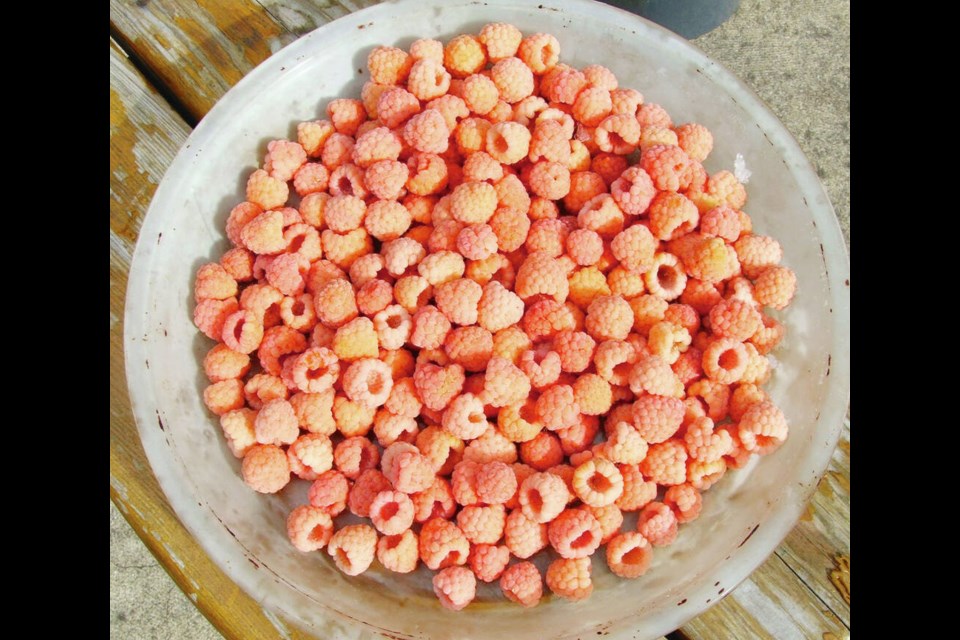Dear Helen: Why are my raspberries not sweet? I grow different kinds, and only the yellow ones are fairly sweet. We fertilize, and water twice a week.
G.S.
Raspberry varieties will differ in their degrees of sweetness, but in general, common causes of bland flavours in the berries are over-watering or/and over-fertilizing with nitrogen.
When berries taste sour, in my experience a common cause is picking before they are really ripe and fully coloured. I’ve come across this curious habit often in my gardening life. Once, when I was away, a neighbour picked my raspberries in exchange for half the harvest. I returned home to bags of frozen raspberries that were not fully coloured and sour.
Another time, I was invited to dinner at which another guest, proud of his cane berries, had brought some of them for “dessert” with ice cream. They were so unripe, and so sour that I felt my stomach curdling into an acidic world of hurt.
Over the years, I’ve pared my raspberry planting down to one variety: Fall Gold, a raspberry that is most forgiving in this respect. Even picked slightly unripe, that is when the berry needs a light tugging to remove it from the cane, the golden berries are still sweet. With other varieties I’ve grown, the berries are optimally sweet only when they almost fall off the cane at a touch.
I am not presuming that picking prematurely is the issue with your un-sweet berries. Still, it’s always a good, and pleasurable, habit to taste-test a little as you pick, to best gauge the look of berries at their peak flavour and sweetness.
Dear Helen: What could have caused tan-coloured blotches on my lilac foliage? The affected leaves look scorched.
T.D.
The problem is most likely lilac leaf miner, caused by tiny caterpillars burrowing into leaves and feeding between the tissue layers. Small brown and silver moths lay eggs on the leaves in spring. The eggs hatch into the damaging larvae. A second generation of adults emerges in summer to produce larvae that feed until autumn.
Pick off infested leaves as soon as they are noticed in spring and summer, while the larvae remain within their leafy tunnels (the “mines”). Do not compost them. Freeze them, or bury them deeply. Rake and similarly destroy all fallen leaves during the summer and in the fall.
Dear Helen: I’ve been enjoying an excellent crop of broad beans. To make room for a follow-up planting in the same spot, I’ve been pulling up the broad bean plants after their pods have all been harvested. I’ve noticed the roots are dotted with tiny white bumps. What are they, and is this a problem?
F.L.
Small white nodules on the roots of peas and beans are formed by soil bacteria called rhizobia, known as “nitrogen-fixing” bacteria. They work in a symbiotic relationship with pea and bean plants, finding a home and (carbon) nourishment from the roots. In return, the bacteria absorb nitrogen and pass it along to benefit the plants.
This is a relationship that benefits pea and bean plants, and the soil. Dug into the soil, or composted, the rhizobia-laden roots help to fertilize the soil by enriching it with nitrogen, a major nutrient for plants.
This beneficial relationship is a feature of legumes, a plant family that includes peas and beans, chickpeas, favas (broad beans) and lentils. In dried form, they are called pulses.
As Dan Jason says in The Power of Pulses, these plants have the ability to “increase the fertility of soil by simply growing in it. They are the epitome of renewable energy.”
Dear Helen: I have agreed to prune a cedar hedge for a friend. What is the preferred timing for the pruning, and are there any clear guides on what to do and what not to do in the process?
D.C.
Mid to late summer, following the plants’ spurt of soft spring growth, is the most commonly recommended timing. To avoid damage to the hedge, avoid doing the pruning during very hot, dry weather.
Prune lightly. Avoid cutting into old wood. Wash the hedge down with a strong flow of water from a hose nozzle afterward, to dislodge cut bits and refresh the plants.
Clean the ground thoroughly following the pruning. Ideally, apply a post-pruning mulch of a nourishing compost after the hedge has been deeply watered.



